
How To Command ChatGPT In The Correct Way?
ChatGPT is an AI model powered by the GPT-3.5 architecture. Generally speaking, it is a cutting-edge language model which has been developed by OpenAI. It can interpret, produce, and imitate human-like text based on the input you give to it. But how to command ChatGPT in the correct way?
Effectively interacting with ChatGPT is crucial to unlock its full potential. Clear communication ensures accurate and valuable responses. This makes the user experience more productive and satisfying.
Register Your Details
Understanding ChatGPT
Understanding ChatGPT is essential for anyone seeking to harness its capabilities effectively. Powered by the GPT-3.5 architecture, this language model operates on a transformer-based design. This incorporates attention mechanisms and an extensive 175 billion parameters. The fun fact is that chatGPT reached 1 million users in just five days after launch. Quite interesting, right?
As per some sources, “openai.com” receives approximately 1.5 billion visits per monthIts. ChatGPT versatility extends across various applications, showcasing prowess in natural language understanding and adaptability to tasks through zero-shot and few-shot learning. Despite these strengths, users must be mindful of limitations, such as the model’s finite context window, which may impact its understanding of lengthy conversations or documents.
Here are some of the ways companies are using ChatGPT:
Use Case | Examples | Companies |
Market Research & Competitive Analysis | Estimating market size, understanding competitor strategies | Fortune 500 companies |
Decision-Making & Investment | Justifying AI adoption, prioritizing features | Startups & SMEs |
Marketing & Customer Engagement | Developing content, personalizing interactions | Marketing agencies |
Risk Management & Ethical Considerations | Monitoring usage, identifying potential risks | Tech giants |
General Guidelines for How To Command ChatGPT
Clear and specific instructions minimize the chances of misinterpretation and enhance the model’s ability to provide accurate responses. When interacting with ChatGPT, here are some general guidelines to keep in mind to get the most effective and useful responses:
Be Specific
Example of commanding ChatGPT in the correct way:
Generic Prompt:

Use this prompt instead:

Provide Context
Example of commanding ChatGPT in the correct way:
Generic Prompt:
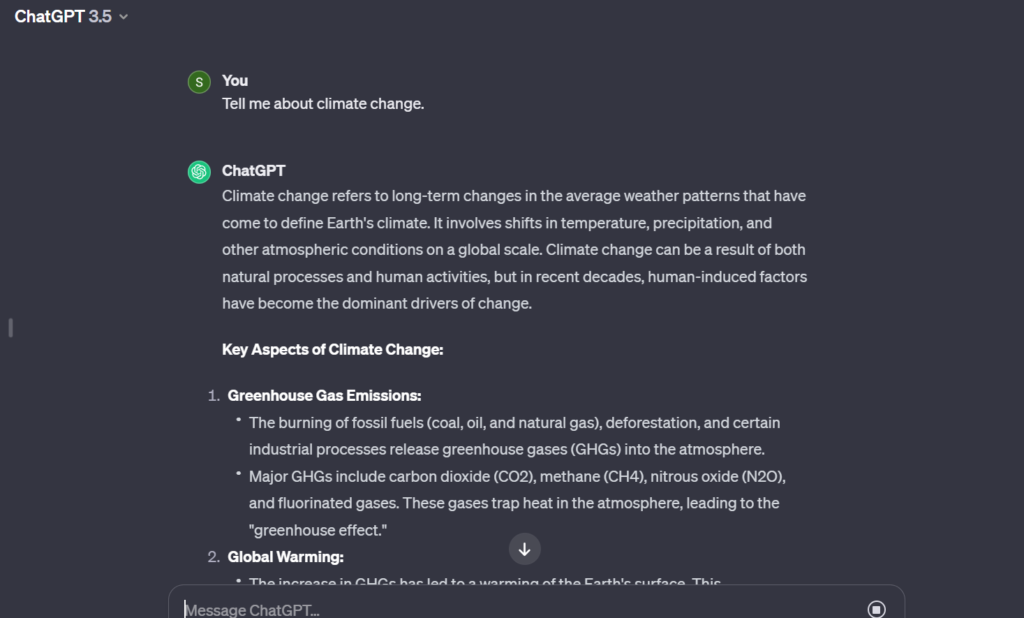
Use this prompt instead:
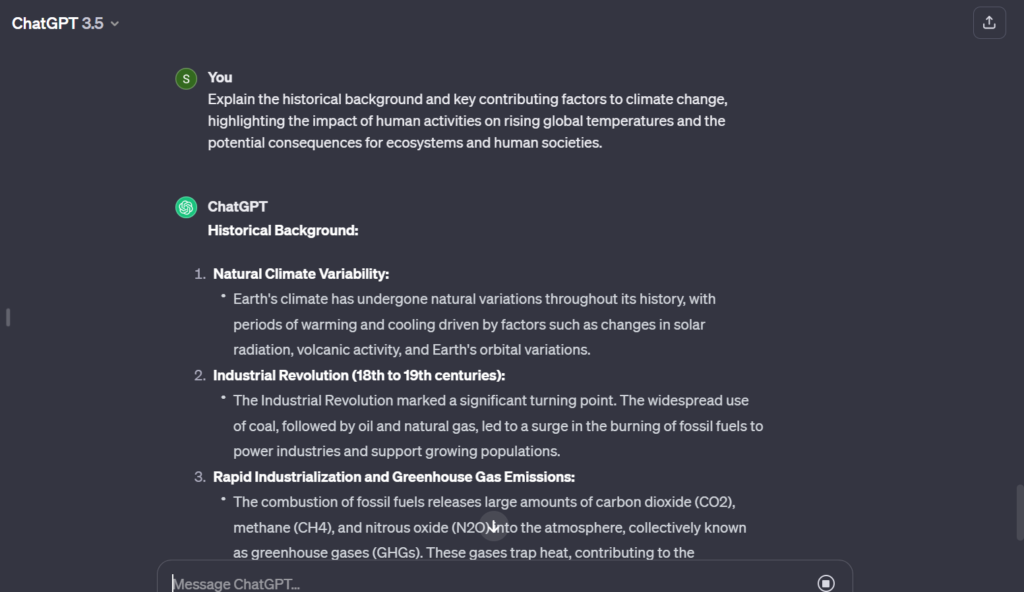
Ask One Question at a Time
Example of commanding ChatGPT in the correct way:
Generic Prompt:
Use this prompt instead:
- What are the recent advancements in space exploration, and how are they shaping our understanding of the universe?
- Explain the current applications of artificial intelligence in various industries.
- How do experts foresee the integration of artificial intelligence in future space missions?
Specify the Format
Example of commanding ChatGPT in the correct way:
Generic Prompt:
Use this prompt instead:
- Provide a bulleted list of the environmental benefits associated with renewable energy sources.
- Share a brief narrative describing the economic advantages of transitioning to renewable energy.
- Summarize any notable challenges or drawbacks associated with the adoption of renewable energy.
Use Follow-up Prompts
Example of commanding ChatGPT in the correct way:
Original Prompt:
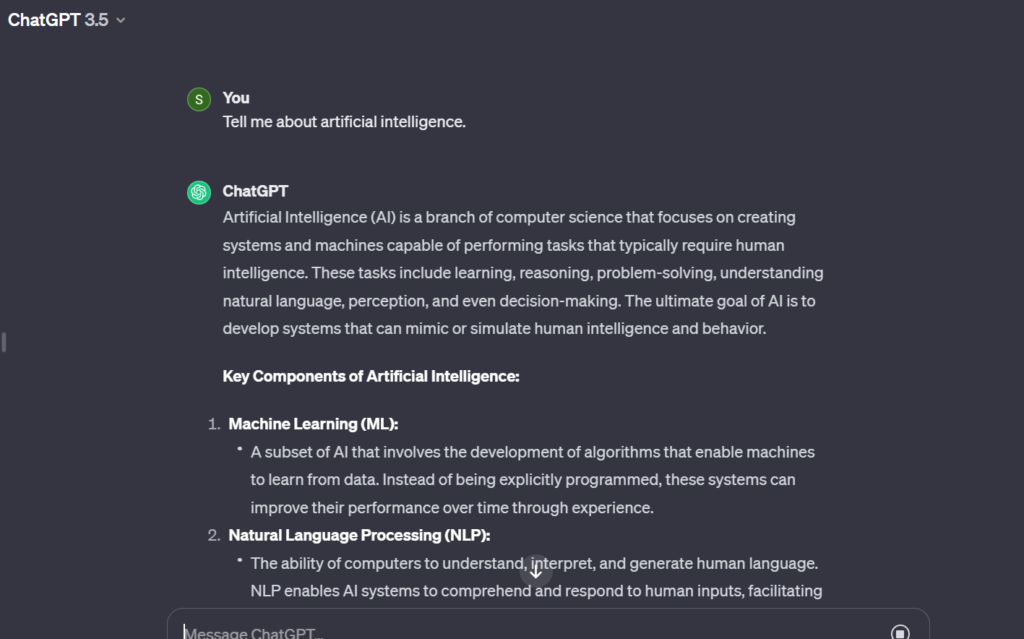
Use this prompt instead:
- Can you elaborate on the key milestones in the development of artificial intelligence, starting from its early days to recent advancements?
- Provide information on significant figures who have played crucial roles in the evolution of artificial intelligence.
- Explain how the goals and focus of artificial intelligence research have shifted over time.

Experiment and Iterate
Example of commanding ChatGPT in the correct way:
Initial Prompt:
Follow-up Iteration Prompt:
- Provide examples of real-world applications where machine learning is currently used.
- Describe the different types of machine learning algorithms and their respective strengths and weaknesses.
- Explain how advancements in machine learning are influencing other fields, such as healthcare or finance.
Use System Instructions
Example of commanding ChatGPT in the correct way:
System Instruction Prompt:

User Instruction 1:

Provide Feedback
Example of commanding ChatGPT in the correct way:
User Prompt:
Use this prompt instead:
Be Patient and Polite
Understand Limitations
ChatGPT has limitations and may not always provide accurate or up-to-date information. It doesn’t have real-time internet access and might not be aware of recent events.
Remember that while ChatGPT is a powerful tool, it’s important to use it responsibly and critically evaluate the information it provides.
Example of Writing a Good Prompt/Command for ChatGPT
Example 1:
“Can you provide me with a concise summary of the key principles of quantum entanglement? Please include any notable experiments or applications that showcase this phenomenon. Use bullet points for clarity, and ensure the information is up-to-date as of 2022.”
This prompt is effective because it:
- Clearly specifies the request: The user is asking for a concise summary of quantum entanglement, including experiments and applications.
- Provides context: The user asks for information up to a specific year (2022), indicating a desire for recent and relevant information.
- Specifies the format: Bullet points are requested for a clear and organized response.
- Asks one question at a time: The user focuses on a single topic, making it easier for ChatGPT to provide a detailed and relevant answer.
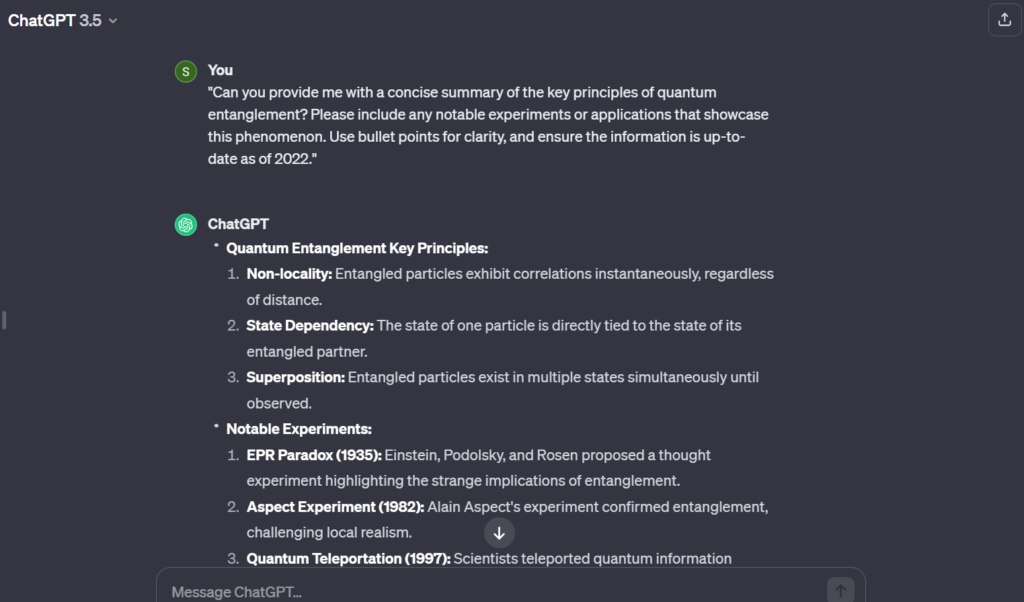
Example 2:
“I am going for a trip to Japan and I wish to get some local insights. Could you recommend must-visit attractions in Tokyo, Kyoto, and Osaka? Additionally, I’m interested in vegetarian-friendly dining options. Please include any travel tips or cultural etiquette I should be aware of during my visit. Break down the recommendations by city for better organization.”
This prompt is effective because it:
- Clearly specifies the request: The user is seeking recommendations for attractions, dining options, travel tips, and cultural etiquette for a trip to Japan.
- Provides context:The user is specific about the cities they are visiting (Tokyo, Kyoto, Osaka) and has a particular interest in vegetarian-friendly dining.
- Specifies the format: The user requests the recommendations to be broken down by the city for better organisation.
- Asks one question at a time:While covering multiple aspects, the prompt is focused on travel-related information, making it easier for ChatGPT to generate a detailed and relevant response.
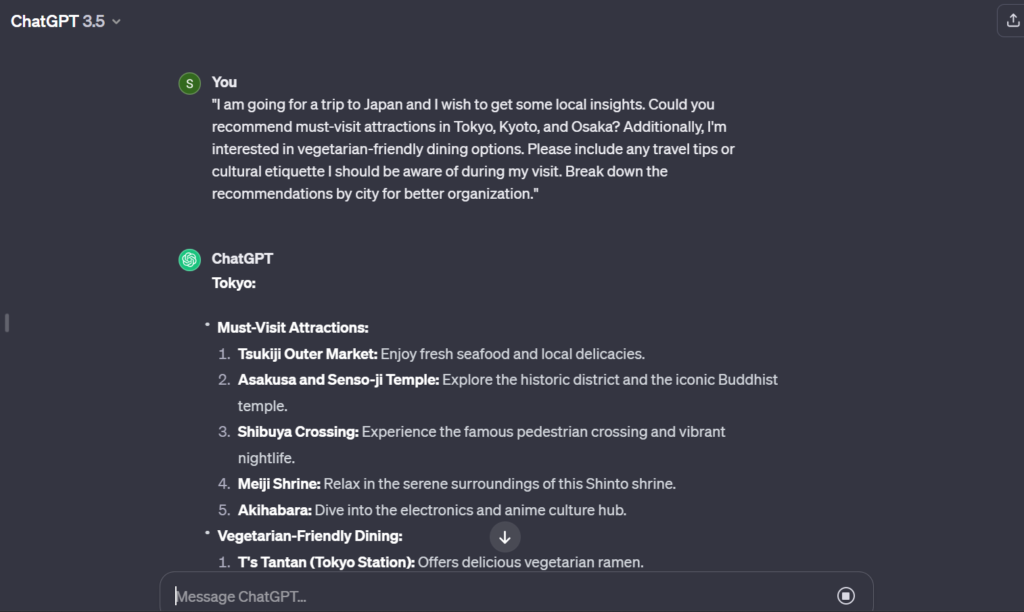
Example 3:
“I’m researching the impact of artificial intelligence on modern workplaces. Could you provide me with the latest insights and trends regarding how AI is transforming work environments? Please include examples of industries or companies that have successfully implemented AI solutions and any challenges they may have faced. Organize the information in a clear and concise manner, and refrain from duplicating content from existing sources.”
This prompt is effective because it:
- Clear Request: The user clearly specifies the topic of interest – the impact of artificial intelligence on modern workplaces.
- Detailed Instruction: The prompt provides detailed instructions on the type of information desired, including the latest insights, trends, successful examples, and challenges.
- Specificity: The user narrows down the focus to industries or companies that have successfully implemented AI, adding specificity to the request.
- Organization Preference: The user specifies a preference for clear and concise organization of information, indicating a desire for a structured response.
- Plagiarism Awareness:The user explicitly requests original content by stating, “refrain from duplicating content from existing sources,” emphasizing the importance of avoiding plagiarism.

Be10x: The Best ChatGPT Course
Join the Be10X ChatGPT Course for a transformative learning experience. Learn to create presentations in under 10 seconds, complete any IT task in under 10 minutes, and elevate your Excel skills to the top 1% to save 90% of your daily work time. At Be10x AI tool Workshop, we believe in empowering individuals with the latest advancements in AI. Explore our AI Tool Workshop and embark on a journey of discovery and innovation.
Enroll with Be10x’s ChatGPT course today to stay at the forefront of AI education.
Conclusion
In the dynamic realm of AI, effectively commanding ChatGPT is an art that requires a deep understanding of the model, clear communication skills, and a responsible approach to experimentation. By adhering to the guidelines outlined in this comprehensive guide, users can harness the full potential of ChatGPT.
Remember, your communication shapes the responses you receive. Whether you’re seeking informative answers, creative content, or problem-solving assistance, following these guidelines will significantly enhance your experience with ChatGPT. Experiment responsibly, communicate clearly, and unlock the endless possibilities that ChatGPT offers. Happy commanding!
